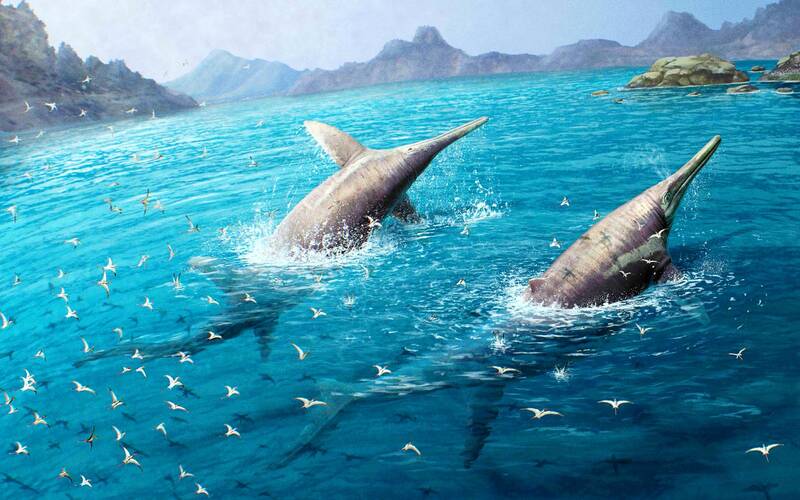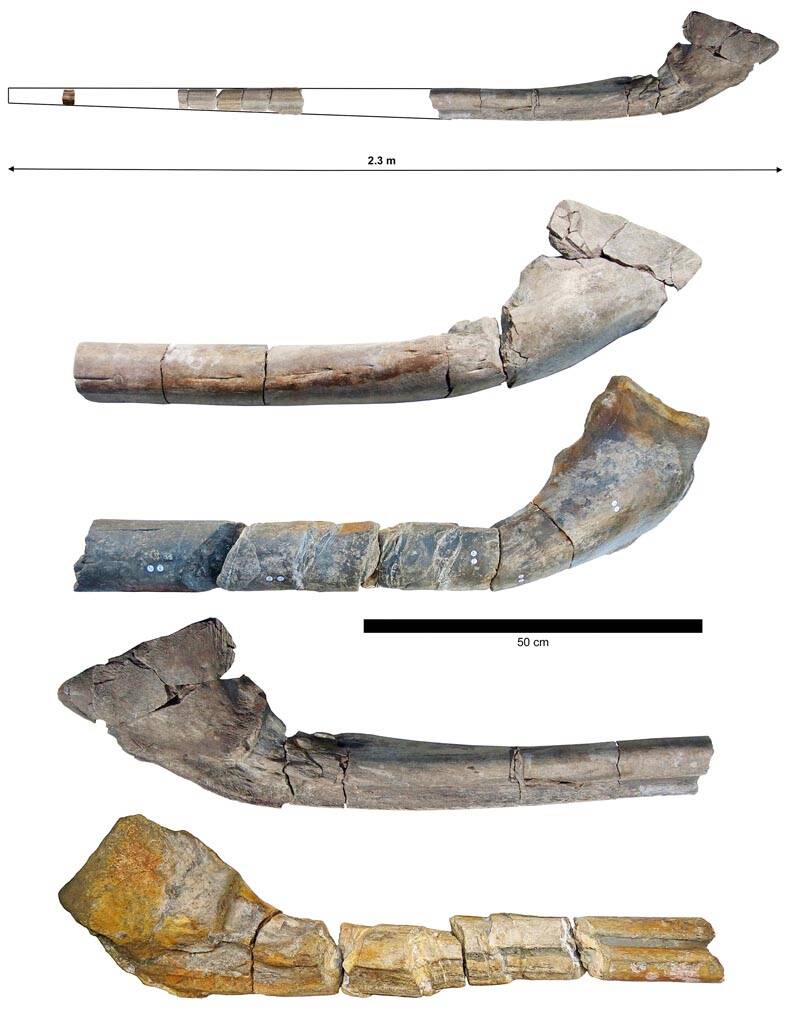A fossil jawbone found by a British girl and her father on a beach in Somerset, England belongs to a gigantic marine reptile dating to 202 million years ago that appears to have been among the largest animals ever on Earth.
Researchers said on Wednesday the bone, called a surangular, was from a type of ocean-going reptile called an ichthyosaur. Based on its dimensions compared to the same bone in closely related ichthyosaurs, the researchers estimated that the Triassic Period creature, which they named Ichthyotitan severnensis, was between 22-26 meters long.
That would make it perhaps the largest-known marine reptile and would rival some of the largest baleen whales alive today. The blue whale, considered the largest animal ever on the planet, can reach about 30 meters long.

Photo: Reuters
Marine reptiles ruled the world’s oceans when dinosaurs dominated the land. Ichthyosaurs, which evolved from terrestrial ancestors and prospered for about 160 million years before disappearing roughly 90 million years ago, came in various sizes and shapes, eating fish, squid relatives and other marine reptiles and giving birth to live young.
Ichthyotitan is known only from two jawbones, the one found by Ruby Reynolds and her father Justin Reynolds in 2020 at Blue Anchor, Somerset, and another from a different Ichthyotitan individual found in 2016, along the Somerset coast at Lilstock.
“It is quite remarkable to think that gigantic, blue whale-sized ichthyosaurs were swimming in the oceans around the time that dinosaurs were walking on land in what is now the UK during the Triassic Period,” said paleontologist Dean Lomax, affiliated with the University of Manchester and University of Bristol, lead author of the study published in the journal PLOS ONE.

Photo: Reuters
Ruby Reynolds, who was 11 at the time and is now 15, was fossil hunting on the beach with her father when they spotted a piece of the surangular. Ruby continued to search the area and found a second piece — much larger than the first — partly buried in a mud slope. They subsequently contacted Lomax, an ichthyosaur expert, and additional sections of the bone were unearthed.
The role of Ruby Reynolds in the discovery has led to comparisons with Mary Anning, the 19th century British fossil hunter and anatomist who, among other things, discovered ichthyosaur fossils when she was 12.
“I think Mary Anning was an incredible paleontologist and it’s amazing to be compared to her,” Ruby Reynolds said.
“It has been an amazing, enlightening and fun experience to work with these experts, and we are proud to be part of the team and co-authors of a scientific paper which names a new species and genus,” Justin Reynolds added.
Fossil collector Paul de la Salle found the 2016 remains now attributed to Ichthyotitan.
Ichthyotitan’s sheer size was awe-inspiring.
“Discoveries like this create incredible moments where we become humbled at our size and place in the world. To learn that an animal of this magnitude once swam our oceans, felt the same warmth of the sun, and breathed our air, and then vanished gives us an opportunity to see how important each species is to the fragile-yet-resilient fabric of life,” Florida-based paleontologist and study co-author Jimmy Waldron said.
Ichthyotitan was a member of a family of giant ichthyosaurs called shastasauridae, and lived 13 million years later than any of the others known to date, suggesting these behemoths survived until a global mass extinction event that doomed numerous types of animals about 201 million years ago at the end of the Triassic.
No fossils of the rest of Ichthyotitan’s skeleton have been discovered, but the researchers have been able to discern its appearance based on other members of its family including Shonisaurus from British Columbia, Canada.
The surangular is a long, curved bone at the top of the lower jaw, just behind the teeth, present in nearly every vertebrate living or extinct, apart from mammals. Muscles attached to this bone generate bite force.
“In T rex, the surangular measures over half a meter in length. The surangular Ruby and her father found stretched more than two meters. This translates to not only the scope of how truly enormous the animal was, but gives us an indication that it had a lot of boost behind its bite,” said Waldron, who founded the Dinosaurs Will Always Be Awesome mobile dinosaur museum.

Sept. 1 to Sept. 7 In 1899, Kozaburo Hirai became the first documented Japanese to wed a Taiwanese under colonial rule. The soldier was partly motivated by the government’s policy of assimilating the Taiwanese population through intermarriage. While his friends and family disapproved and even mocked him, the marriage endured. By 1930, when his story appeared in Tales of Virtuous Deeds in Taiwan, Hirai had settled in his wife’s rural Changhua hometown, farming the land and integrating into local society. Similarly, Aiko Fujii, who married into the prominent Wufeng Lin Family (霧峰林家) in 1927, quickly learned Hoklo (commonly known as Taiwanese) and

The low voter turnout for the referendum on Aug. 23 shows that many Taiwanese are apathetic about nuclear energy, but there are long-term energy stakes involved that the public needs to grasp Taiwan faces an energy trilemma: soaring AI-driven demand, pressure to cut carbon and reliance on fragile fuel imports. But the nuclear referendum on Aug. 23 showed how little this registered with voters, many of whom neither see the long game nor grasp the stakes. Volunteer referendum worker Vivian Chen (陳薇安) put it bluntly: “I’ve seen many people asking what they’re voting for when they arrive to vote. They cast their vote without even doing any research.” Imagine Taiwanese voters invited to a poker table. The bet looked simple — yes or no — yet most never showed. More than two-thirds of those

In the run-up to the referendum on re-opening Pingtung County’s Ma-anshan Nuclear Power Plant last month, the media inundated us with explainers. A favorite factoid of the international media, endlessly recycled, was that Taiwan has no energy reserves for a blockade, thus necessitating re-opening the nuclear plants. As presented by the Chinese-language CommonWealth Magazine, it runs: “According to the US Department of Commerce International Trade Administration, 97.73 percent of Taiwan’s energy is imported, and estimates are that Taiwan has only 11 days of reserves available in the event of a blockade.” This factoid is not an outright lie — that

Former Chinese Nationalist Party (KMT) chairwoman Hung Hsiu-chu’s (洪秀柱) attendance at the Chinese Communist Party’s (CPP) “Chinese People’s War of Resistance Against Japanese Aggression and the World Anti-Fascist War” parade in Beijing is infuriating, embarrassing and insulting to nearly everyone in Taiwan, and Taiwan’s friends and allies. She is also ripping off bandages and pouring salt into old wounds. In the process she managed to tie both the KMT and the Democratic Progressive Party (DPP) into uncomfortable knots. The KMT continues to honor their heroic fighters, who defended China against the invading Japanese Empire, which inflicted unimaginable horrors on the